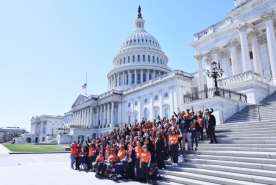September 14, 2023
The National Kidney Foundation (NKF) recently joined a coalition of kidney community stakeholders to encourage the Centers for Medicare and Medicaid Services to significantly increase the payment base rate for dialysis services rendered to patients living with kidney disease. This recommendation was part of public comments that NKF submitted on the End-Stage Renal Disease (ESRD) Prospective Payment System (PPS) and the Quality Incentive Program (QIP) for the Calendar Year 2024 Proposed Rule and is part of our ongoing efforts to advocate for effective and efficient payment policies for Medicare beneficiaries living with kidney disease. NKF policy staff routinely comment on regulatory proposals and issue policy statements on important topics that affect kidney patients. Learn more about our regulatory advocacy.
Improving Access to Care
NKF also strives to advance the alignment of comprehensive quality measures across federal programs to improve access to care and achieve health equity. An increased payment rate, administered and utilized as efficiently as possible, would help to alleviate dialysis facility closures and staff turnover in the current execution of kidney patient care.
Voices for Kidney Health Advocate Erich Ditschman noted in his contribution to our comments, “As a patient advocate, I visit numerous dialysis centers in the Midwest on a regular basis. Many home dialysis programs are hurting from a lack of staff and patients interested in going home are not able to be trained. Consolidation of home dialysis facilities forces patients who want to achieve their best life with dialysis to drive long distances, or even worse, at times not be able to make the switch from in-center dialysis. When this happens, dialysis patient lives are in jeopardy.”
Do you want to make a difference like Erich? Become a Voices for Kidney Health Advocate today! Using your voice and sharing your story makes change possible.
Impending Dialysis Facility Closures
Concurrent inflationary pressures and supply chain disruptions are two reasons large dialysis organizations have reported as contributing factors to facility closures. One large dialysis organization closed 58 facilities in 2022 and 53 facilities in 2023. Another large dialysis organization recently closed approximately 170 facilities in 2023. These closures increase hospitalization rates within 180 days, contribute to an increased risk of mortality, and cause patients to drive longer distances to receive care, particularly in rural and underserved areas.
Staff Turnover
Sustained low labor wages over the last decade have contributed to the exodus of skilled dialysis healthcare workers to other industries and early retirement. Employee churn negatively impacts the relationship established between patients and their care team. Staff members experiencing burnout have led to substandard quality of care and equity issues for certain sectors of the patient population.
Your Voice Makes All the Difference
Less than adequate healthcare coverage, inequitable clinical practices, decreased access to novel therapies and devices, and deficient patient education and awareness are only a few pervasive problems we aim to address in addition to the lasting impacts of dialysis facility closures and ongoing staffing shortages. Alongside our regulatory policy efforts, we also advocate for a legislative agenda that would advance similar goals and are constantly working to ensure key decision-makers on these issues hear directly from members of the kidney community like you. To learn more about our advocacy efforts, please visit kidney.org/advocacy for more information!









